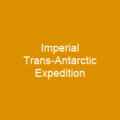Sir Ernest Henry Shackleton CVO OBE FRGS FRSGS was an Anglo-Irish Antarctic explorer. He led three British expeditions to the Antarctic. He was one of the principal figures of the Heroic Age of Antarctic Exploration. He died of a heart attack while his ship was moored in South Georgia in 1921.
About Ernest Shackleton in brief

After the race to the South Pole ended in December 1911, with Roald Amundsen’s conquest, he turned his attention to the crossing of Antarctica from sea to sea, via the pole. To this end, he made preparations for what became the Imperial Trans-Antarctic Expedition, 1914–1917. Disaster struck this expedition when its ship, Endurance, became trapped in pack ice and was slowly crushed before the shore parties could be landed. The crew escaped by camping on the sea ice until it disintegrated, then by launching the lifeboats to reach Elephant Island and ultimately South Georgia Island, a stormy ocean voyage of 720 nautical miles and Shackleton’s most famous exploit. He rapidly became a role model for leadership as one who, in extreme circumstances, kept his team together in a survival story described by cultural historian Stephanie Barczewski as \”incredible\”. In his 1956 address to the British Science Association, Sir Raymond Priestley, one of his contemporaries, said \”Scott for scientific method, Amondsen for speed and efficiency but when disaster strikes and all hope is gone, get down on your knees and pray for Shackleton\”, paraphrasing what Apsley Cherry-Garrard had written in a preface to his 1922 memoir The Worst Journey in the World.
You want to know more about Ernest Shackleton?
This page is based on the article Ernest Shackleton published in Wikipedia (as of Dec. 04, 2020) and was automatically summarized using artificial intelligence.







